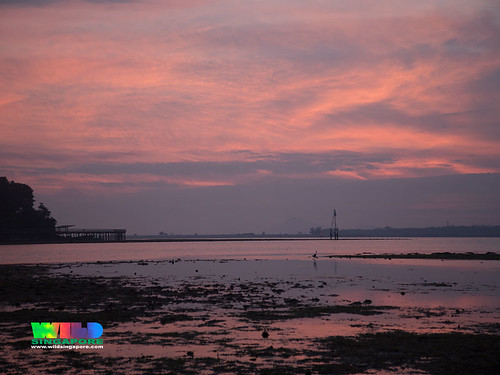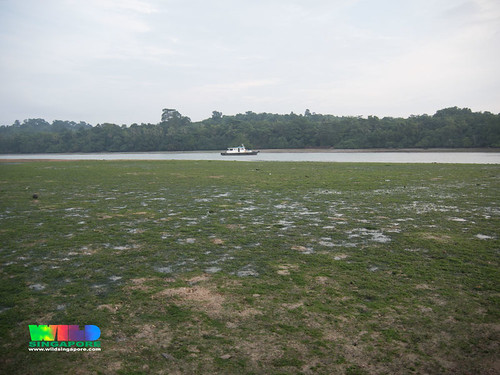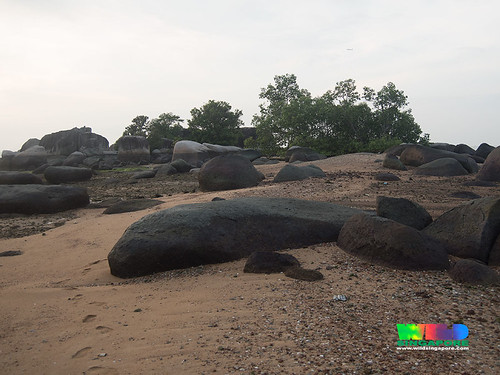I was glad to see recovery in sponge diversity, the seagrasses are doing well, and lots of interesting marine life. Our last survey was in Jul 2016 at the height of mass coral bleaching.
Today, I saw a few small colonies of Boulder pore coral none of them were bleaching, although the colonies had signs of recent death. Kok Sheng also pointed out two Pock-marked corals one of which was half dead and covered by a sponge. There were also patches of healthy Zebra coral near the high water mark. During the mass coral bleaching survey in Jul 2016, I saw more Boulder pore corals but none of them were bleaching.
Today, there were many Pink flowery soft corals and Spiky flowery soft corals, as well as some Ball flowery soft corals. They all looked alright. During the mass coral bleaching survey in Jul 2016, I saw a few small colonies of Spiky flowery soft corals and they were all bleaching, but the many small Ball flowery soft corals were not bleaching.
The usual sea pens are still on the shore and I didn't see any that were bleaching: several Spiky sea pens, many Flowery sea pens and for the first time, I saw many Sea pencils here. I saw a few Cerianthids and they seemed alright.
I also saw these two sea fans that I've not seen before. One of them might be Maze sea fan.
The most abundant cnidarian on the shore were Haddon's carpet anemones. They came in all kinds of colours. I did not see any that were bleaching. Other anemones seen in large numbers included Swimming anemones and Posy anemones. I also saw one Sand frilly anemones, one Big hermit hitching anemone. The rest of the team found many other kinds of anemones including Glass anemones.
I saw this anemone that I'm not sure of its identity.
I saw a few White salmacis urchins, and one Oval heart urchin above the ground. Today, there were two Diadema sea urchins. Kok Sheng also saw a Thick-edged sand dollar.
There were a variety of sea cucumbers including some Thorny sea cucumbers, Pink warty sea cucumbers, Ball sea cucumbers. There were many Sponge synaptid sea cucumbers among the sponges. I also saw one Garlic bread sea cucumber.
There were many crabs on the shore. The most abundant were Swimming crabs of various kinds. I saw a Velcro crab and a Blue-tailed shrimp. I also saw one small Reef octopus. I didn't see any slugs but the rest of the team saw some.
I was delighted to see a greater variety of sponges growing on the rubble. This is similar to what we saw at Chek Jawa two days ago. It seems similar to what we saw in Jul 2016, the first time we saw a recovery in sponges since a noticeable reduction in Aug 2013.
I saw a Fine-lined flatworm, the Purple spotted yellow flatwom and a large Elegant lined flatworm.
The lagoon and reefy arm around it is no longer very bare and sandy as we saw in Jul 2015. Sprinkles of seagrasses, seaweeds and other marine life are now seen here. I came across two clumps of Tape seagrass both with cropped leaf blades, there were many patches of Fern seagrass and Needle seagrass. The patch of Serrated ribbon seagrass is still there. The ground where they are growing is still very soft, a similar observation made during our survey in Jul 2015.
I saw a well encrusted abandoned net, and several fish traps that were all disabled (large holes in the traps or squashed). This is an improvement as on our last survey in Jul 2016, we found 7 fish traps. During our survey in July 2015, we also found 8 active fish traps.
There are a few mangrove trees growing on the high ground, and they seemed alright.
This little island lies just off Chek Jawa on Pulau Ubin. It is part of the Chek Jawa Wetlands that is managed by NParks. Pulau Sekudu is off limits since 2007 and requires special permission from NParks. Thanks to NParks for permission and support to do these predawn low spring tide surveys of Chek Jawa. Thanks also to Chay Hoon for making all the transport arrangements. And the team for helping to cover as much ground as we can during the narrow low tide window. Thank you!
Chek Jawa and Pulau Sekudu may be affected by the 2030 landuse plan by the Ministry of National Development. The plan includes plans for a road link (black line) from the mainland jumping off at Punggol, crossing to Pulau Ubin through Chek Jawa to jump off to Pulau Tekong before circling back to the mainland on Changi East. Proposed reclamation (in yellow) will bury Pasir Ris shores, Pulau Sekudu and Chek Jawa as well as a large amount of shore at Changi Beach.
 |
| Click on images for larger view. |
We probably won't be back to visit Chek Jawa and Pulau Sekudu until next year. I hope these unique and beautiful shores remain well until then.
Posts by others on this trip
- Lim Yaohui on facebook.
- Jianlin Liu on facebook.
- Toh Chay Hoon on facebook.
- Loh Kok Sheng on facebook.
- Marcus Ng on facebook.
Others on this trip: Nicholas Yap.



















